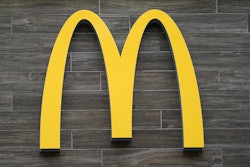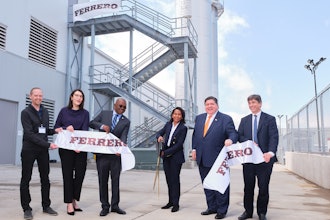
Thailand is in a boom phase, evident from the numerous construction projects visible not only in its capital city of Bangkok, but also dotting its countryside. And to help the Southeast Asian country transition into its new world status, the Thailand Board of Investment (BOI) is busy rolling out investment packages in a number of industries.
“To move Thailand forward, we have identified ten industries that we are targeting,” said BOI Deputy Secretary General Chokedee Kaewsang.
One of those targeted industries is the food manufacturing sector. BOI is seeking local and foreign investors and offering tax and non-tax incentives to companies that could further develop Thailand's food industry. “The food industry has been developed and promoted for many years, but we want to develop the food for the future,” said Kaewsang.
The strategy is part of the plan for Thailand 4.0 — the name of the country’s broader investment into an innovation-driven economy. The concept echoes the digital transformation happening in other parts of the world.
For the food industry, Thailand has set a goal of moving from the No. 14 food exporter in the world to No. 10. To do this, the National Food Institute (NFI), part of Thailand’s Ministry of Industry, has set in motion a 20-year plan to promote the nation's food industry.
“We have identified three new food segments: future food, convenient food and commodities,” said Yongvut Saovapruk, president of the NFI.
With a focus on increasing productivity and innovation, the country is eager to attract new food producers, in addition to helping the existing food companies that drive Thailand's food industry.
Here is a closer look at several food companies already active in Thailand’s food production industry.
Thai Union
Thai Union is a 41-year-old company that started out as a canned tuna processor. The company is still primarily just that, but it also managed to buy some of the biggest canned tuna brands in the world, such as Chicken of the Sea in 2006 and King Oscar in 2014.
However, the company is fully aware that canned tuna has something of an image problem. Mainly, it’s seen by the typical millennial consumer as a food item for an older generation. A lot of that has to do with a lack of innovation in the tuna processing industry. “The processing of canned tuna, much of it is the same as it was 40 years ago,” said Tunyawat Kasemsuwan, director of global innovation for Thai Union.
In 2015, the company established the Global Innovation Incubator (GII), located in Bangkok, to connect with the consumer and be the most trusted seafood leader. The GII was created in a partnership with Mahidol University.
“Seafood is a fragmented industry,” said Kasemsuwan. “Our mission is to be a leader in seafood innovation.”
 Thai Union is using different types of equipment to develop new products, such as its Yellowfin Tuna Slices, which are the world’s first pre-sliced, pre-seasoned tuna made from whole yellowfin tuna loins and produced by high pressure processing.
Thai Union is using different types of equipment to develop new products, such as its Yellowfin Tuna Slices, which are the world’s first pre-sliced, pre-seasoned tuna made from whole yellowfin tuna loins and produced by high pressure processing.With that in mind, Thai Union started SeaChange, a digital traceability pilot program to deliver supplier information and create more connectivity throughout the supply chain. The GII also has a number of product innovation rooms devoted to producing new seafood offerings, such as tuna slices and fish sausages.
Thai Union has approximately 49,000 workers, but plans to introduce more automation at its plants in the future. “We still have people doing a lot of work by hand,” said Kasemsuwan.
The company is also is using different types of equipment to develop new products, such as its Yellowfin Tuna Slices, which are the world’s first pre-sliced, pre-seasoned tuna made from whole yellowfin tuna loins and produced by high pressure processing (HPP). The Yellowfin Tuna Slices recently received the 2018 Seafood Excellence Award in the category of Best New Foodservice Product category at the Boston Seafood Expo North America in March.
Betagro
Agro and food business company Betagro Group was founded in 1967. The company, which earned $2.67 billion in revenue last year, is focused on producing high quality, safe and nutritious chicken, pork and egg products. Betagro processes approximately 34 million birds per week, 17.7 million pork heads per year and 43 million eggs per day.
The company strives to be a leader in food safety and quality. In line with that goal was the establishment of a Research & Development center just outside of Bangkok in 2005. Betagro performs a variety of microbiological food safety testing — including ELISA, PCR and culture based tests — at that facility. “Food safety is not something you can ignore,” said Betagro Vice President of R&D Rutjawate Taharnklaew.
 Betagro processes approximately 34 million birds per week, 17.7 million pork heads per year and 43 million eggs per day.
Betagro processes approximately 34 million birds per week, 17.7 million pork heads per year and 43 million eggs per day. Betagro is focused on producing high quality, safe and nutritious chicken, pork and egg products.
Betagro is focused on producing high quality, safe and nutritious chicken, pork and egg products.Although those lab services are mostly done for in-house testing of Betagro’s products, the facility's services can be used by other companies in the industry.
Betagro also conducts genomic sequencing on its products, but it does not own the equipment. Instead, it collaborates with its nearby neighbor, the National Science and Technology Development Agency (NSTDA).
The company also works closely with Thai and international universities. One project has researchers breeding the Black Soldier Fly to eat organic waste on Betagro's farms. The company is also working on projects to improve technology system management and R&D system improvements.
CP Thai Rice Company
Located about a two-hour drive from Bangkok is the largest rice processing plant in Thailand. The Nakhon Luang Rice Plant has the capacity to produce 1.08 million tons of rice per year.
CP Thai Rice Company opened the $100 million plant in May 2012. The facility took several years to build, with the goal of improving rice selection, quality and packaging operations. The facility has allowed the company to become the fourth-largest rice exporter in Thailand. Not too shabby considering Thailand is the second-largest country in the world rice trade, only surpassed by India, according to USDA information from May 2018.
CP Thai Rice Company produces rice under the Royal Umbrella brand, as well as other trademarks and co-packs for U.S. retailers such as Walmart and Costco. Forty-two percent of its exported rice is jasmine and hom mali rice, 26 percent is parboiled and the rest is a mix of broken rice and white rice.
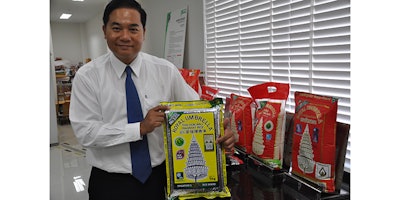 CP Thai Rice Company produces rice under the Royal Umbrella brand, as well as other trademarks and co-packs for U.S. retailers such as Walmart and Costco.
CP Thai Rice Company produces rice under the Royal Umbrella brand, as well as other trademarks and co-packs for U.S. retailers such as Walmart and Costco.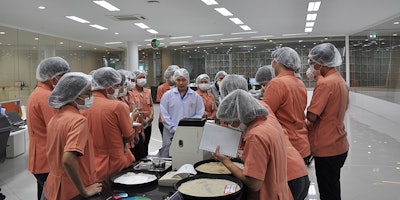 CP Thai Rice Company’s Nakhon Luang Rice Plant, which opened in 2012, is the largest rice processing plant in Thailand.
CP Thai Rice Company’s Nakhon Luang Rice Plant, which opened in 2012, is the largest rice processing plant in Thailand.In total, the company produces 1.6 million tons of milled rice per year from a total of five plants. The Nakhon Luang plant was built with hygienic standards on par with those of an RTE production facility, and has received a number of domestic awards. The building is a closed structure with smooth, seamless floors to reduce any dust accumulation. Hygienic materials were used in construction to minimize contamination, and the different areas of production are physically separated.
The first step of the raw material processing is cleaning the rice. From there, the rice goes to the destoner for removal of foreign materials, and then is polished to remove its skin. The rice is then moved to a rotary sifter before being put onto a length grader. Rice then is sent to the color sorter room, which cost $7 million to build and stock with equipment. Then it is moved into a high-speed packaging area and undergoes metal detection and checkweigher inspection.
“Fourteen years ago we had a small rice miller with low capacity, so we looked for higher efficiency and much higher capacity machinery to build higher volume,” said Vice President of Production Thammavit Srikrekkrit. “And we invested in lab equipment to analyze the components of quality rice.”
Cargill Meats Thailand
Global food producer Cargill has been in Thailand for decades, having first opened a trading office in 1968. Since then, the company has established 13 facilities in the country — employing 17,000 — and is now known as Cargill Meats Thailand (CMT). The company produces 125,000 metric tons of fully cooked, ready-to-export product.
“Thailand is the largest cooked chicken exporter, and Cargill is the largest cooked chicken exporter in Thailand,” said Hans Kabat, President of Cargill Protein Southeast Asia.
CMT exports to 28 countries, but not to the U.S. or China due to restrictions on Thailand exports. The company continues to invest in Thailand because of its strategic location, infrastructure, skilled workforce and investor-friendly environment. CMT recently invested $50 million in an expansion, which raised its total production capacity by 25,000 metric tons per year.
 Cargill Meats Thailand has a fully integrated and fully controlled supply chain — from its agricultural operations to the primary processing of its poultry.
Cargill Meats Thailand has a fully integrated and fully controlled supply chain — from its agricultural operations to the primary processing of its poultry.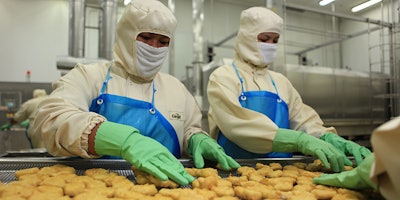 Cargill Meats Thailand produces 125,000 metric tons of fully cooked, ready-to-export product each year.
Cargill Meats Thailand produces 125,000 metric tons of fully cooked, ready-to-export product each year.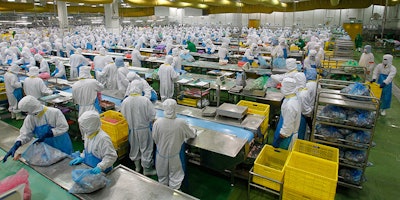 Cargill Meats Thailand, which has 13 facilities in the country, employs approximately 17,000 workers.
Cargill Meats Thailand, which has 13 facilities in the country, employs approximately 17,000 workers.The company has a fully integrated and fully controlled supply chain — from its agricultural operations to the primary processing of its poultry, to the preparation, cooking and final steps of its finished goods. At its biggest processing plant two hours north of Bangkok, the CMT employs 15,000.
The plant has made strides to improve its water management and renewable energy usage, including using recycled wastewater in more 35 percent of its water applications.
The plant receives raw poultry from a 150-kilometer radius surrounding the plant. When the chicken is received, it is tested for microbial bacteria and pesticides. It is then divided into 1,000-kilogram batches, which undergo an approximately hour-long cooking process. The chicken is tumbled in brine in a separate room before being wheeled in containers onto the main production floor, where it is manually put on conveyor belt and coated in flour and breaded while being conveyed.
Line workers are constantly checking for quality throughout the conveying process, and don't wear gloves to avoid ruining the coating on the chicken. “There is a two minute hand washing break after every batch is processed,” said Watcharapon Prasopkiatpoka, managing director of the plant.
After the product is breaded, it is conveyed to the cooking room where it can undergo frying and oven baking. Temperature readings are taken and the whole batch is individually quick frozen. After 30-70 minutes, depending on the product size, the product is placed into bags, sealed and sent through a metal detector. Roughly 700 tons of finished product can be stored on site, before being shipped out.
The plant produces 150-200 active SKUs, but mainly produces three to four products for its largest foodservice customers. However, due to the variation in products, the plant floor configuration is highly flexible and equipment is on wheels so it can easily be moved and changed out.
For now, the plant uses a mix of manual labor and automation because it suits the type of production.
“In animal protein processing, you buy a whole animal and have to make something out of it,” said Kabat. “You can do it with less labor, but yields are better with manual labor.”
As part of its growth strategy, CMT is investing in R&D and is shifting to become consumer-centric. The company wants to understand the end-user's purchasing habits so it can help its retailer customers' product portfolio. “We reach a lot of different people in a lot of different eating occasions in a lot of different countries,” Kabat said. “So we are looking at different packaging and products that are geared toward the consumer.”
Jelly Belly
Located in Thailand's southeast industrial development corridor about two hours from Bangkok is the only Jelly Belly plant located outside of the U.S. The family-owned business, whose U.S. plants are located in California and Illinois, wanted to grow its international business.
“It's tough in the U.S. to service customers outside it, and our international business wasn't growing,” said Herman Rowland, Jr., who represents the fifth generation in the family business, and currently serves as the managing director the Thailand plant. His father, Herman Rowland, Sr., chairman of Jelly Belly’s board, was searching for an international location for more than a year.
Thailand was picked because of its abundance of sugar and access to tapioca syrup for its development of non-GMO products. “We wanted access to sugar and good prices on syrup and labor,” said Rowland, Jr. “Plus, the labor is wonderful, it's a great country, a happy place; the land of smiles.”
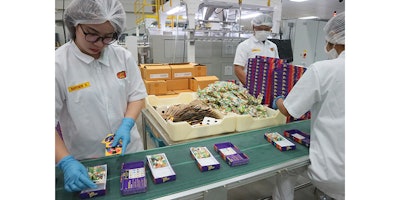 Located in Thailand's southeast industrial development corridor about two hours from Bangkok is the only Jelly Belly plant located outside of the U.S.
Located in Thailand's southeast industrial development corridor about two hours from Bangkok is the only Jelly Belly plant located outside of the U.S. Jelly Belly’s Thailand plant employs approximately 150 workers and produces 150 different types of jelly beans.
Jelly Belly’s Thailand plant employs approximately 150 workers and produces 150 different types of jelly beans.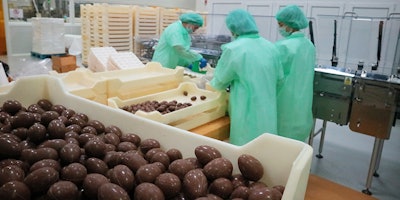 Jelly Belly has expanded three times in its decade-long history in Thailand. Now it’s beginning yet another expansion — a new chocolate production facility.
Jelly Belly has expanded three times in its decade-long history in Thailand. Now it’s beginning yet another expansion — a new chocolate production facility.Jelly Belly has expanded three times in its decade-long history in Thailand. Now it’s beginning yet another expansion — a new chocolate producing facility.
“Chocolate is an allergen and when we are producing it, we have to keep everything separate and shut all other production down, which is why we want the separate building,” said Rowland, Jr.
Jelly Belly’s plant typically employs 150 workers and produces 150 different types of beans. The company as a whole produces 1,300 SKUs. The products made in the Thailand plant are shipped to approximately 65 countries. The plant also produces all of the chocolate products for the company.
“We are getting to a diversification stage,” said Rowland, Jr. “We've had all our jelly beans in one basket.”
In total, the plant produces 7 million pounds of candy per year, puts out approximately 10 tons of beans per day and has the capacity to produce up to 32,000 pounds of jelly beans per day.
Jelly Belly production starts by combining sugar, starch and other ingredients together and cooking the mixture with colors and flavors in four vessels. The product then enters the mogul where the Jelly Belly center is made. Afterwards, this product goes into a dry room for one-to-three days. It then gets a sugar bath to develop its sugar coating in a tumbler.
The beans then move to a finishing and polishing room to build up their shell. One operator is responsible for all the product contained in ten machines and determines when the shell is complete — a skill that takes up to three years to learn. Afterwards, the beans are moved to a tray storage room where they can stay up to ten days.
“It takes seven to ten days to make a bean, but by the time it gets packaged, it can be 30 days,” said Don Helton, general manager of the Thailand plant.
That’s because the shell needs time to cure and firm up before beans are ready to be bagged, otherwise they will sweat, which can cause quality issues. When QA determines the beans are ready, the product is sent to one of 12 packaging lines.
As for other future investments in addition to the planned expansion, the company is considering adding an automated six-kettle line to increase its throughput.
Thai Otsuka Pharmaceutical
Japanese drug and nutraceutical producer Otsuka Group first expanded internationally in 1973 when it opened operations both in Thailand and the U.S. Worldwide, the company employs 45,000 people and 2,000 of those workers staff seven Thai factories. It is the third-largest pharmaceutical company in Japan.
Split into two divisions — pharmaceutical and nutraceutical — 70 percent of the company’s revenue comes from its drug side. However, Otsuka sees its nutraceutical products, including its popular hydration and electrolyte replacement beverage POCARI SWEAT, as a stable revenue platform, said Shinsuke Yuasa, president of Thai Otsuka Pharmaceutical.
 Thai Otsuka Pharmaceutical is focused on developing products based on scientific evidence and creating new categories for medical food and beverages. Some of its recent research has involved food products for seniors with kidney problems, people that can only eat small portions and those who have absorption issues.
Thai Otsuka Pharmaceutical is focused on developing products based on scientific evidence and creating new categories for medical food and beverages. Some of its recent research has involved food products for seniors with kidney problems, people that can only eat small portions and those who have absorption issues.The company is focused on developing products based on scientific evidence and creating new categories for medical food and beverages. Some of its recent research has involved food products for seniors with kidney problems, people that can only eat small portions and those who have absorption issues.
The Thai plant, which is located an hour’s drive outside of Bangkok, currently produces the company’s Enteral Nutritional products. This plant is only two years old and churns out a total of six brands and approximately 12 SKUs.
To produce this medical food in powder form, ingredients are transferred from a separate room to the emulsifier where the formula is mixed together. It is then homogenized to ensure the emulsification is complete. The mix is then heat pasteurized and transferred to the spray dryer, located in a separate room. After the powder is collected here, it is sent to another mixing room where vitamins and minerals are added. The powder is then sent to the packaging lines.
Only one type of product is produced here per week. The plant operates 24 hours a day, five-and-a-half days a week, closing for approximately a day and a half for both clean-in-place and manual cleaning. During the course of a day, between 10-12 tons of powder is produced.
The company is mostly producing powder as its primary medical food product, but is looking to develop more platforms, such as liquid applications and bars. “Powder is 80 percent of the market,” said Yuasa. “But we want to develop more convenient, ready-to-drink products for busy consumers.”






